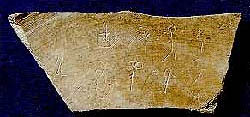News & Updates
Calligraphy
Calligraphy is considered uniquely Asian, and is a cultural treasure trove. It is considered not only a written form of communication in the Asian world, but also an artistic expression capable of reflecting meaning beyond the written word to communicate style, expression, and culture of the artist in how that person creates a brush stroke. It is certainly an important part of Chinese culture, which has spread to the rest of the Asian world, including Vietnam, Korea, Japan and Singapore. Calligraphy is definitely elevated in Asian society and is considered to contain artistic expression which lacks in the Western written communication. Some experts consider modern calligraphy to be the most condensed form of abstract art, and the first expression of it.
When did calligraphy originate? This question probably interests everyone who wishes to study calligraphy. Although no precise date is given in ancient Chinese history, tradition indicates that a man named Cang Jie who lived during the reign of the Yellow Emperor is credited with the invention. Recent archaeological discoveries have authenticated that 4,500 years ago is when the Chinese language started and logic dictates that a rudimentary form of calligraphy appeared around that time.
 At left is a photo of an ancient sunrise painting. The painting was a design inscribed on a big-mouthed pottery jar-a sacrificial vessel to the sun by primitive Chinese forebears in Shandong during the period when the Dawenkou culture thrived. Surviving writings made with a metal tool are much older than surviving writings made with a brush/ calligraphy. It is estimated to be 4300 years old.
At left is a photo of an ancient sunrise painting. The painting was a design inscribed on a big-mouthed pottery jar-a sacrificial vessel to the sun by primitive Chinese forebears in Shandong during the period when the Dawenkou culture thrived. Surviving writings made with a metal tool are much older than surviving writings made with a brush/ calligraphy. It is estimated to be 4300 years old.
Not all inscriptions that have survived were done by means of a metal tool. Some were first drawn with a brush, and then traced with a metal tool or inscribed on bone or shell later on. This piece of pottery below is too complicated to have been inscribed directly on the pottery initially. (4000-2000 BC).
The two primitive calligraphic works are both inscribed on pottery pieces by sharp tools. Therefore in the opinion of calligraphic historians they are the earliest works written by means of sharp tools-a sort of metal brush, or "hard" brush.
True enough, these inscriptions are outstanding examples of ancient Chinese calligraphy written by means of a metal tool. However it’s impractical to think all  inscriptions on bone or tortoise shell were done by a metal tool. It is concluded that most were first drawn by a brush and later inscribed onto bone or hard surface later. So, the conclusion that the art of calligraphy has more than four thousand years of history in China seems well substantiated. Certainly, anyone who has mastered calligraphy after years of study has a deep appreciation for this original expression of language, culture and art for in the Asian world.
inscriptions on bone or tortoise shell were done by a metal tool. It is concluded that most were first drawn by a brush and later inscribed onto bone or hard surface later. So, the conclusion that the art of calligraphy has more than four thousand years of history in China seems well substantiated. Certainly, anyone who has mastered calligraphy after years of study has a deep appreciation for this original expression of language, culture and art for in the Asian world.
Book References Guo, Bonan 1995. Gate to Chinese Calligraphy. Beijing: Foreign Languages Press.
Source: http://www.chinavoc.com/arts/calligraphy.htm
 Chinese Visa Information
Chinese Visa Information Vietnam Visa Procedure
Vietnam Visa Procedure Arch RoamRight Insurance
Arch RoamRight Insurance